Compound copper pipes: instructions and comparison of various installation technologies
Copper pipes are used in the installation of hot water supply, hot water supply, air conditioning, heating, and gas supply systems.They are expensive, but durable, flexible, and resistant to corrosion. But in order for engineering communications from them to last for decades, the connection of copper pipes must be done correctly.
We will tell you how to install copper pipelines that ensure the tightness of the transported medium or circulating coolant. The article presented for review describes installation technologies in detail. Taking into account our advice, the construction of the systems will be completed perfectly.
The content of the article:
The nuances of working with copper pipes
To install internal pipelines in the house, you can choose a pipe made of plastic, metal-plastic or stainless steel. But only the copper analog can last for more than half a century without problems or major repairs.
Properly installed copper pipeline systems in practice work properly throughout the entire service life of a cottage or apartment building.
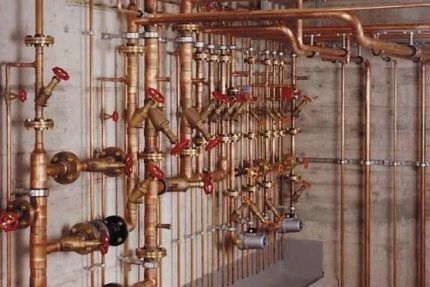
Copper pipes are not afraid of long-term heat loads, chlorine and ultraviolet radiation. When they freeze, they do not crack, and when the temperature of the internal environment (water, wastewater, gas) changes, they do not change their geometry.
Unlike plastic analogues, copper pipelines don't sag. This plastic is subject to expansion at high temperatures; this does not happen with copper by definition.
Copper pipe products have two disadvantages - high price and softness of the metal. However, the high cost of the material pays off with a long service life.
And to prevent the walls of the pipes from being damaged from the inside by erosion, filters must be installed in the system. If there are no contaminants in the water in the form of solid particles, then there will be no problems with the destruction of pipelines.
Requirements for pipe processing and welding
When working with copper pipes, the following rules must be observed:
- When installing hot water supply or hot water supply by soldering, you should avoid using lead solder - lead is too toxic.
- The water flow speed should be no higher than 2 m/s, otherwise the smallest particles of sand or other solid substance will gradually begin to destroy the walls of the pipe.
- When using fluxes, after completion of installation, the pipeline system must be flushed - flux is an aggressive substance and will contribute to corrosion of copper pipe walls.
- When soldering, do not allow the joint to overheat - this can lead not only to the formation of a leaky joint, but also to a loss of strength of the copper product.
- Transitions of pipes from copper to other metals (steel and aluminum) are recommended to be made using brass or bronze adapter fittings - otherwise steel and aluminum pipes will quickly begin to corrode.
- Burrs (metal deposits) and burrs at cutting sites must be removed - their presence leads to the formation of turbulent turbulence in the water flow, which contributes to erosion and reduces the service life of the copper pipeline.
- When preparing copper pipes for connection, it is strictly forbidden to use abrasives - particles remaining inside after installation will lead to damage to the metal and the formation of a fistula.
If in the water supply or heating system in a house, in addition to copper, there are also pipes or elements made of other metals, then the water flow should go from them to copper, and not vice versa. The flow of water from copper to steel, zinc or aluminum will lead to rapid electrochemical corrosion of the latter sections of the pipeline.

Due to the ductility and strength of the metal, copper pipes can be cut and bent without problems. Rotation of the pipeline can be done either by using a pipe bender or using fittings. And for the installation of branches and connections with various devices, there are many parts made of heat-resistant plastics, brass, stainless steel and bronze.
On the interaction of copper with other metals
In most private homes, domestic water pipes are assembled from steel and aluminum pipes. Heating systems also contain radiators made of steel or aluminum. Incorrect insertion into such copper pipe routing is fraught with considerable problems.
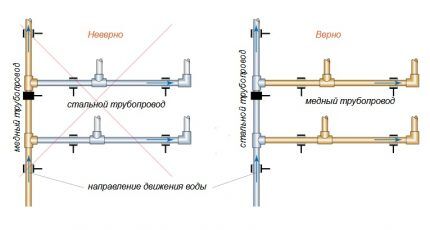
The most optimal installation option is to use pipes and devices exclusively made of copper and its alloys. Nowadays you can easily find bimetallic aluminum-copper radiators, as well as corresponding fittings and shut-off valves. It is worth combining different metals only in extreme cases.
If combination is inevitable, then copper should be the final element in the chain of pipeline elements. It is impossible to rid it of its ability to conduct electric current.
And in the presence of even a weak current, this metal creates galvanic pairs with steel, aluminum and zinc, which inevitably leads to their premature corrosion. When installing a water supply system, bronze adapters must be inserted between them.
Another potential problem is oxygen in the water. The higher its content, the faster the pipes corrode. This applies to pipelines both made of the same metal and those made of different ones.
Often, cottage owners make a serious mistake by frequently changing the coolant in the heating system. This only leads to the addition of completely unnecessary portions of oxygen. It is best not to completely change the water, but to add it when the need arises.
Mounting choice: detachable vs permanent
To connect copper pipes into a single pipeline system, you can use several ways to connect them. Various plumbers use crimp and press fittings, welding or soldering. But before you start work yourself, you need to decide whether the pipeline should be permanent or detachable.
There are three installation technologies for connecting copper pipes:
- electric welding;
- soldering using a torch or electric soldering iron;
- pressing.
All these technologies can be used in the formation of both detachable and one-piece systems. Here it is more a matter of using a variety of fittings and adapters or refusing them.

If the pipeline system needs to be detachable, and also easier to repair and add new elements, then the connections must be made detachable.
Fittings are used for this:
- compression;
- threaded;
- self-fixing.
It is easier to make detachable connections yourself; you can even do without soldering. They do not require excessively high qualifications from the master.
However, such units require constant inspection and tightening of the nuts to prevent leaks. Changes in pressure and temperature in the system lead to weakening of the fasteners. And from time to time it is recommended to tighten them.
If access to copper pipes is planned to be tightly closed with finishing or concrete screed, then it is best to connect them into an integral structure by soldering or welding. This system is more reliable, durable and resistant to abrasions.
Carvings are prohibited on copper products. This metal is too soft in its structure. When installing a detachable pipeline, all threaded connections must be made using fittings. The latter can be connected to a copper pipe by pressing or soldering.
Before making connections, copper pipes are prepared in a special way:
Three main connection methods
Before connecting sections of copper pipes, they must be cut in accordance with the wiring diagram and prepared. You will need a pipe cutter or hacksaw, a pipe bender and a file. And for cleaning the ends, fine-grained sandpaper will not hurt.
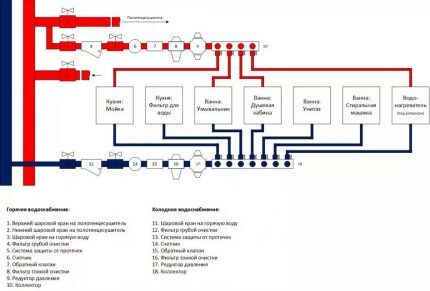
Only having a diagram of the future pipeline system in hand can you calculate the required amount of consumables. It is necessary to decide in advance where and what diameter the pipes will be installed. It is also necessary to clearly understand how many connecting elements are required for this.
Option #1: Welding copper pipes
To perform automated or manual welding of copper pipes, electrodes and gas are required to create a protective environment (nitrogen, argon or helium). You will also need a DC welding machine and, in some cases, a torch. The electrode can be graphite, tungsten, copper or carbon.
The main disadvantage of this installation technology is the significant differences in the characteristics of the resulting seam and the pipe metal. They differ in chemical composition, internal structure, electrical and thermal conductivity. If welding is performed incorrectly, the joint may even separate later.
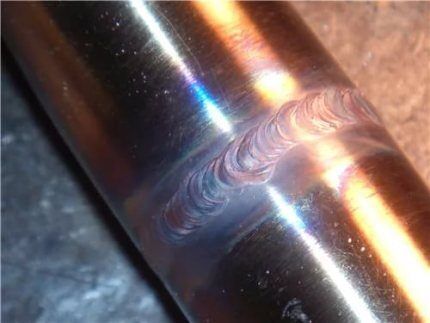
Only a qualified craftsman can properly weld copper pipes. This requires certain knowledge and skills.
This installation option has a lot of technological nuances. If you plan to do everything yourself, but have no experience working with a welding machine, then it is better to use a different connection method.
Option #2: Capillary soldering
In domestic conditions, copper pipes are rarely connected by welding plumbing fixtures. It is too complex, requires specialized skills and is time consuming. It is easier to use the capillary soldering method using a gas torch or blowtorch.
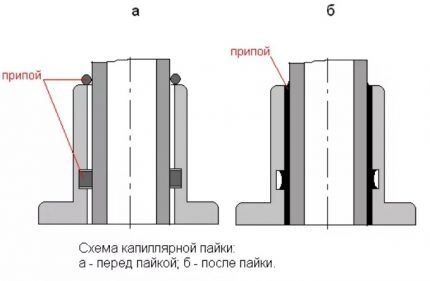
Soldering of copper pipes happens:
- low temperature - soft solders and a blowtorch are used;
- high temperature - refractory alloys and a propane or acetylene torch are used.
There is no particular difference in the final result of these copper pipe soldering methods Dont Have. The connection in both cases is reliable and tear-resistant. The seam with the high-temperature method is somewhat stronger.However, due to the high temperature of the gas stream from the burner, the risk of burning through the metal of the pipe wall increases.
Solders are used based on tin or lead with the addition of bismuth, selenium, copper and silver. However, if pipes are soldered for a drinking water supply system, then it is better to avoid the lead option due to its toxicity.
There are two methods for soldering copper pipelines:
- bell-shaped;
- using fittings.
The first option involves expanding the end of one of the connected pipes with a special expander. Then this socket is put on the second pipe, and the joint is soldered using solder.
The end is expanded so that there is a gap of 0.1–0.2 mm between the outer and inner walls of the connected products. No more is needed. Solder on it, due to the capillary effect, will still fill the entire available gap.
In this technology, it is important not to damage the pipe during expansion. If it is made of solid copper (R 290), it will have to be pre-fired. In this case, the metal at the joint acquires the properties of a soft analogue. It is important not to forget about these changes when calculating operating pressure parameters in the pipeline.
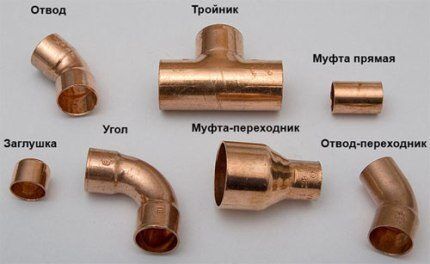
To simplify the soldering of copper pipeline elements with your own hands, it is enough to purchase ready-made couplings, turns, tees and plugs. They already have the necessary bell. The use of these parts increases the cost of installation work, but greatly simplifies it.
To clean the metal at the soldering site and lubricate the solder, the ends of the connected pipes are coated with flux. It should only be applied to the outside of pipe walls. It does not treat sockets and fittings from the inside. This is simply not necessary.
To perform soldering, the pipes are inserted into the socket and heated with a burner. When the desired temperature is reached, solder is applied to the gap. It begins to melt and flow inside.
If too much of it gets into the joint, it will leak out from inside the pipeline, which will lead to a narrowing of the internal diameter of the pipe. And if the flow rate is low, the connection will be insufficiently soldered.
If problems arise with the use of solder, then you can use fittings that already have it in the required volumes. To simplify the work, a capillary belt made of the appropriate alloy is now inserted into these connecting elements at the factory from the inside. This part just needs to be put on the pipe and heated with a burner.
Option #3: Push-in fittings and press couplings
One-piece copper pipe connection can also be done using press couplings or compression (collet) fittings. They use an O-ring instead of solder. The first option is clamped onto the pipe with special pliers, and the second - with union nuts and a wrench.
When the nut is tightened, the end of one copper pipe is pressed against the other. As a result, the copper is ground in, creating a strong, gap-free connection. Leaks when using such couplings are practically eliminated.
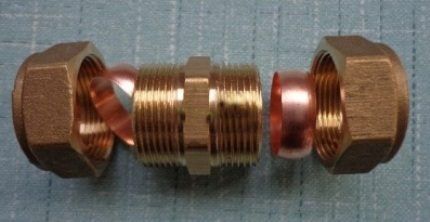
To assemble and install a copper pipeline you will need specialized pipe cutter, designed for dividing this particular type of material into segments. Our article will introduce you to the guidelines for choosing this tool.
Conclusions and useful video on the topic
You can see what working with pipes looks like in practice in the following videos.
Video #1. All about soldering copper pipes with a gas torch:
Video #2.Analysis of typical mistakes in connecting copper pipes with soft solder:
Video #3. About the features of installation of press fittings:
There are several ways to connect copper pipes with fittings. Some of them are easier to do yourself, while others are cheaper, but require special tools. There is nothing particularly complicated about such installation.
However, before you start directly soldering the pipeline, it is worth practicing using the torch. During work, the copper must not be burned.
Do you know the technological nuances of connecting copper pipes that are not mentioned in the article? Would you like to tell us how you assembled a copper pipeline with your own hands? Please write comments in the block below, ask questions, share your impressions and photos on the topic.




I noticed that wherever I came across copper pipes, they preferred to connect them by soldering. Although, in principle, it is possible to use fittings, it will just take a little longer. But somehow the adapters have never been found yet. I don't even know why this is so. Maybe because without them the joints are practically invisible and can be easily painted over with paint of a suitable color. I would probably also use soldering to connect it myself.